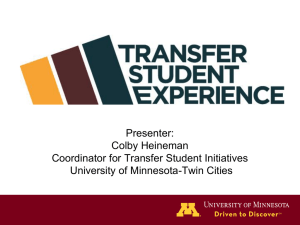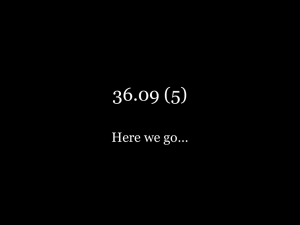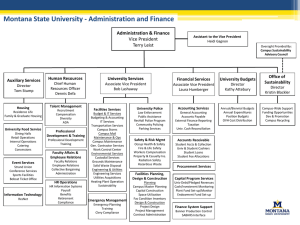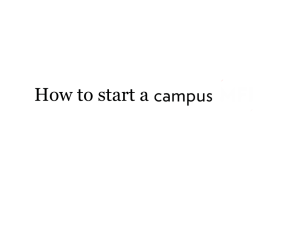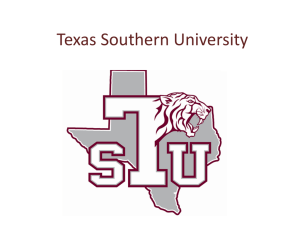Reducing Drinking and Driving on Campus
advertisement
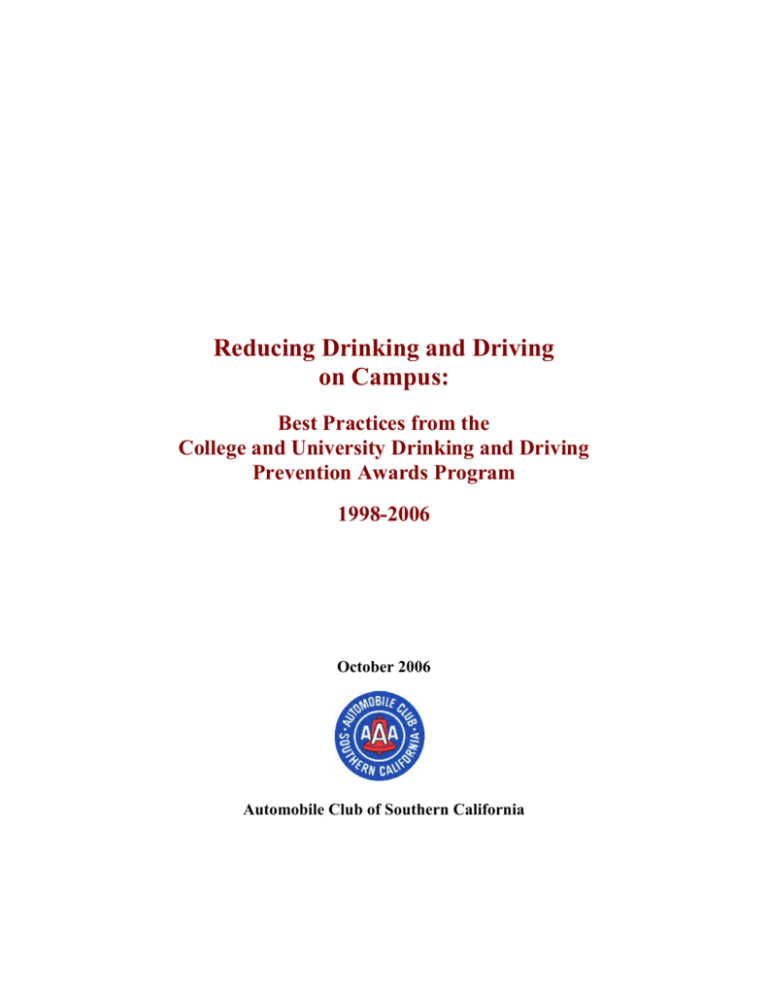
Reducing Drinking and Driving on Campus: Best Practices from the College and University Drinking and Driving Prevention Awards Program 1998-2006 October 2006 Automobile Club of Southern California ABOUT THE COLLEGE AND UNIVERSITY DRINKING AND DRIVING PREVENTION AWARDS PROGRAM The College and University Drinking and Driving Prevention Awards Program was initiated in 1997 by the Automobile Club of Southern California and the Higher Education Center for Alcohol and Other Drug Prevention, a role now assumed by the Center for College Health and Safety. The award is co-sponsored by AAA Texas, AAA New Mexico, AAA Hawaii, and AAA Northern New England (Vermont, New Hampshire, and Maine). Automobile Club of Southern California The Automobile Club of Southern California is the largest affiliate of AAA. The Auto Club has been committed to improving the traffic safety of its members and the general public since its founding in 1900. The Auto Club participated in AAA's groundbreaking efforts in K-12 alcohol education, drinking and driving treatment and high school traffic safety education. The Auto Club maintains a variety of ongoing DUI and traffic safety programs, including a bilingual Spanish-English community outreach; school alcohol education; mature operator program; alcohol, DUI and traffic safety education; and legislative advocacy. Further information about Club programs and services is available at www.aaa-calif.com. Center for College Health and Safety The Center for College Health and Safety assists colleges and universities in developing, implementing, and evaluating prevention policies and programs to address a broad range of health and safety issues at institutions of higher education. The Center also conducts research to expand current knowledge about effective strategies in promoting health and preventing alcohol, tobacco, and other drug use, violence and injuries, and high-risk sexual activity. The Center's services include professional development, technical assistance, publications, and a broad array of electronic communication resources. The Center for College Health and Safety is based at Health and Human Development Programs, a division of Education Development Center, Inc., an internationally known educational research and development organization located in Newton, Massachusetts. For more information, visit www2.edc.org/cchs/. 1 Table of Contents Introduction…………………………………………………………………………….1 Overview of the Problem…………………………………………………………… 1 College and University Drinking and Driving Prevention Awards Program… Classification of Award Winners…………………………………………………… Best Practices Model Programs…………………………………………………….. A. Changing Alcohol Intentions…………………………………………………… B. Changing Alcohol Environments……………………………………………… C. Promoting Harm Reduction or Health Protection………………………… D. Treating or Intervening……………………………………………………… E. Multiple Emphases…………………………………………………………… Summing Up: What Makes a Good Program?.......................................................... Additional Resources………………………………………………………………. Appendix: Award Winning Campuses…………………………………………. Program Advisory Group………………………………………………Inside back cover 2 Reducing Drinking and Driving on Campus: Best Practices from the College and University Drinking and Driving Prevention Awards Program Introduction Overview of the Problem In recent years, awareness of alcohol problems on college campuses has grown significantly as policies and programs responding to problems have risen in number and prominence. Despite these efforts, serious problems remain: High-risk drinking by students has not declined significantly in recent years and binge drinking remains in excess of 40% among college students. The binge drinking of college students exceeds that of non-college students the same age. More than 500,000 college students (aged 18-24) were estimated to have been unintentionally injured because of drinking More than 600,000 college students have been estimated to have been hit/assaulted by another drinking student More than 1,700 college students died in alcohol-related incidents. This estimate (2001) represents an increase of about 9% compared to three years earlier (1998). The proportion of students aged 18-24 who reported drinking and driving during the previous year increased from 26.5% to 31.4% during the period from 1998 through 2001. While the range of alcohol-related problems among college students has been widely reported, the contribution of drinking and driving to overall mortality and morbidity has been less noted. Most importantly, of the 1,717 college students estimated to have died in alcohol-related incidents, nearly 80% were killed in drinking and driving crashes. Efforts to deal with the problem of alcohol on campus have often not recognized the difficulty or complexity of campus alcohol problems. Efforts have frequently failed to: clarify the targets of program efforts include a broad spectrum of program strategies (changing individuals and their intentions, improving campus environments and changing norms, enforcing existing policies, and treating those with demonstrated problems) or evaluate ongoing programs to determine either their operational needs or program effectiveness deal specifically with drinking and driving. One estimate is that just 5% of campus alcohol programs focus directly or indirectly on drinking and driving. College and University Drinking and Driving Prevention Awards Program 3 The College and University Drinking and Driving Prevention Awards Program was developed in 1997 by the Automobile Club of Southern California and the Higher Education Center for Alcohol and Other Drug Prevention to respond to the continuing campus need for innovative and effective approaches to alcohol and other drug problems. Its goal is to identify and disseminate model approaches to reducing drinking and driving on campus and preventing alcohol and other drug use that can result in impaired driving. As of fall 2006, the Prevention Awards Program operates in eight states – California, Texas, New Mexico, Hawaii, Texas, Vermont, New Hampshire and Maine – under the auspices of the Automobile Club of Southern California, AAA New Mexico, AAA Texas, AAA Hawaii, AAA Northern New England, and the Center for College Health and Safety. This booklet provides summaries of the 41 colleges and universities that, since 1998, have received Prevention Program awards. More in-depth descriptions (one to two pages in length), and contact information for individual prevention programs (those operating since 2003) can be obtained from www2.edc.org/cchs/. Classification of Award Winners Following the model for program classification established by the Higher Education Center, award winners are grouped into one of four major types depending on the kind of intervention they emphasize. The four intervention emphases identified by the Higher Education Center are: A. changing alcohol intentions: changing people's knowledge, attitudes and behavioral intentions regarding alcohol use B. changing alcohol environments in which alcohol is used. Environments include 1) group norms, 2) providing alcohol-free options, 3) reducing alcohol availability, 4) reducing alcohol promotion and marketing, 5) enforcing alcohol policies and laws C. promoting harm reduction or health protection to reduce the negative consequences of alcohol use, through activities such as safe ride or designated driver programs D. treating and intervening with offenders and those with alcohol problems Programs with multiple, not easily classifiable emphases are presented under: E. multiple emphases Best Practices Model Programs 4 A. Changing Alcohol Intentions New Mexico State University (2006) The Wellness, Alcohol & Violence Education (WAVE) Program was used to educate the campus about responsible alcohol use, laws and limits, and bystander intervention. Programs included: Weekly advertising in the student newspaper using social norming messages and promoting alcohol-free events Peer educator presentations to incoming freshman in “Freshman Experience” and English 111 classes (that nearly all freshman take) Presentations and tabling efforts during freshman orientation week Twice weekly tabling in the student union using weekly themes such as “Operation Moderation,” “Agent Aggie,” Homecoming, St. Patrick’s Day, etc. Sending birthday cards, in conjunction with the President’s Office, to all students and their parents on the student’s 21st birthday with tips on making responsible choices Training health center counseling and residential staff on motivational interviewing Champlain College (Vermont, 2006) The newly created Alcohol/Drug Education Coordinator position instituted a social norms program. An Alcohol and Drug Advisory Council of faculty, staff and students was formed to collaboratively plan Alcohol and Drug Awareness Week, Alcohol Screening Day, and Safe Spring Break. Program elements included a: Poster program: Students designed posters, students led focus groups to give feedback on poster designs, and students gave out prizes to their peers for correctly identifying poster messages Webpage redesign: Classes were invited to re-design the Counseling webpage; student interns created PowerPoint presentations and brochures on topics including alcohol and other drugs. Student work was posted on the webpage Student orientation enhancement: an interactive theater program was developed around alcohol acquaintance rape performed by students for parents and students; and the film “Spin the Bottle,” which looks at how the alcohol industry targets college students, was screened. Orientation giveaways (including bookmarks and key chains) were designed with the social norms logo and information. Sam Houston State University (Texas, 2005) Hosted a Save A Life Tour! Drunk Driving Simulator, a state-of-the-art, interactive device allowing people to experience how alcohol affects driving skills. 150 students took part. Developed a Bacchus & Gamma norms campaign titled “Seize the Keys.” (with a slogan “Carpe Key-em.”) Worked with the Recreational Sports department and a newly formed Alcohol Abuse Initiative Committee to host National Collegiate Alcohol Awareness Week. Used fatal vision goggles, hosted a popular guest speaker, and added a Health Programming Coordinator to its staff. Texas A&M University (2005) Used MeetingNet® registered software and wireless keypads to develop an immediate feedback/response system for use in interactive presenta- 5 tions to groups on campus. Students were able to immediately see and compare how they and their peers answered various questions. The software has been used in more than 100 presentations since 2002 (to over 11,000 students annually), including presentations to fraternities and, for three years, to all the Fish Camps (supplemental orientation events annually attended by 4,500 freshmen). Goals of the program were to increase the perception that most students choose not to drink and drive or drive under the influence. Sul Ross State University (2004), in Alpine, Texas, a town of 6,000 people with the highest beer sales per capita in the state, implemented a CHOICES (Choosing Healthy Options in Community Environments) program that created on-line screening resources to allow students to anonymously screen themselves for alcohol problems; implemented a freshman seminar to address underage drinking and risky drinking behavior; offered a nationally acclaimed guest presenter about alcohol on campus; and developed a peer mentors program. Peer mentors play an active role during freshman orientation to educate students about alcohol, offer a "Ride on the Mall" exhibition before major holidays in which students drive around in golf carts using fatal vision goggles, and provide outreach to neighborhood high schools to promote alcohol prevention messages. Texas A&M University (2003) "The Choice is Up to You. Make Responsible Decisions." was a broad-scoped campaign initiated for the campus and surrounding community to emphasize responsible decision making. Training was conducted with numerous campus individuals and groups, including residence hall directors and advisors, the Judicial Board, off-campus resident advisors, orientation "camp" freshman counselors, designated driver program staff, and teaching assistants for athlete life skills classes. A "Coalition on Alcohol Responsibility and Education" was formed with city government, law enforcement, MADD and other advocacy groups. TV advertisements were created showing students discussing the "Choice" message and highlighting school drinking and driving norms; 271 ads appeared on MTV and Comedy Central. A Football Frenzy program provided alcohol education materials and foam footballs with the "Choice" message before home football games. "Bee a good neighbor" neighborhood walks provided local students with information about state alcohol laws. University of Texas at Austin (Grand Prize Winner, 2002) Wide-ranging Longhorns Against Drunk Driving program was designed to educate students and change campus norms. Efforts included: Broad-scale media outreach program that included different types of stuffers, stickers, posters, radio PSAs, T-shirts, website, newspaper ads, on-campus TV announcements, and mall displays Completion of numerous campus alcohol education presentations, awareness programs, administration and faculty presentations, media releases, and new student educational orientations Seasonal campaigns and other campus programs using campus norms messages, including "Wellfest," holiday programs, and Alcohol Awareness Week 6 California State University, Bakersfield (2002) Extensive weeklong alcohol education theme week, OKSOBERFEST, designed to support students who choose not to drink, while promoting drinking safety for those who do drink and are of legal age, and providing drinking alternatives. Components included: A foodfest and rally, a speakers program, a Fatal Vision "drunk driving" course to demonstrate the impairments of alcohol (on walking, picking up objects, etc.), and a free non-alcoholic smoothies day Extensive use of media, such as fliers, posters, emails about events, advertisements, banner, red ribbons, education tables, designated driver cards New Mexico State University (2002) Choices program (also see Section B, below) implemented to enhance the decision making skills of NMSU students with regard to alcohol. Program particularly targeted campus high alcohol consuming groups: athletes, freshmen and members of the Greek community. Components included: Peer educators program to train students to deliver alcohol prevention presentations campus-wide promotional events each semester, including biannual "Stress Out," promoting student relaxation and stress management without alcohol; wrecked car exhibition; National Alcohol Screening Day; music festivals; and student health fairs Outreach, including media campaigns (radio station messages, advertisements of the availability of peer educators, student newspaper educational campaign) and materials (numerous display tables, merchandise with messages) Presentations to groups on campus, including freshman, athletes and dorm students Westminster College (Utah, 2002) Drinking/Driving Prevention program designed to reach selected, generally difficult-to-reach sectors of the campus, including commuters, hard-to-target older students (23-35 years of age) who do not believe they have a problem, and residential students. Regular efforts made by staff, student government, and faculty to personally encounter students at various locations on campus and distribute warm beverages and candies, as well as alcohol and traffic safety education materials. University of California, Santa Barbara (Grand Prize Winner, 2001) Comprehensive DUI and BUI (bicycling under the influence) efforts (also see B, below) that included: Curriculum infusion of alcohol and other drugs, DUI/BUI subject matter into the regular curriculum through "Students Teaching Alcohol and other drug Responsibility" (STAR). Also, a Sociology 'Reader's Theater', which trained students to perform and facilitate discussion for all incoming students and others Isla Vista Community Development Peers, in which students were hired and assigned blocks in the community to conduct community meetings and awareness programs of various issues, including AOD abuse prevention Southwest Texas State University and University of Texas at Austin (2001) Joint production and promotion of "A Night to Remember: The Truth About DWI" video depicting a 7 college student leaving a party after drinking, being arrested, meeting with a lawyer, and undergoing a trial. The film became the basis for performance of a live mock trial. San Jose State University (California, 2001) (Also see Section B, below.) Use of Prevention Education Program Student Educators' (PEP-SE) creative methods to conduct a wide-ranging outreach to students and campus organizations to increase alcohol awareness. Outreach included education; coordination with faculty, athletes and Greeks; and alternative activities (Alcohol and Drug Game Night, etc.) University of California, Berkeley (2000) "BEARS" Program focused most of its effort on UC Berkeley's Greek community, which had seen increasing problems with alcohol abuse. Based on the principle of peer education, fellow fraternity and sorority members were trained as BEARS educators who worked to create a positive campus environment that discouraged inappropriate high-risk choices. A two-unit BEARS educator class was designed to train students to give alcohol-awareness presentations to peers. El Paso Community College, Rio Grande Campus (Texas, 1999, 2000) EPCC increased awareness of the dangers of drinking and driving among a diverse, heavily Latino group of students, staff and community members. Focusing on the holiday season, the school planned a series of major events, most notably a DUI prevention parade with floats that circulated through the school and, particularly in its second award-winning year, through the surrounding community and other EPCC campuses. The parade included a wrecked car and emergency vehicles. Other events included a poster contest, Balloon Release Rally, candlelight vigil, Memorial Wall about persons killed in DUI crashes, and a community resource fair, bringing together professionals to educate community members and students about community programs and issues. East New Mexico University (2000) BACCHUS-led, broad coalition designed a program addressing many of the campus' alcohol problems during alcohol awareness week. The goal was to show students, particularly in residence halls, the effects of drinking on driving and that there are other campus activities besides drinking. Alternative activities were developed and implemented and an educational program begun. Program used Fatal Vision goggles, brochures on "How to Host a Responsible Party," a brick wall where campus freshmen's positive or negative experiences with alcohol were posted, alcohol trivia contests, including during a major TV football game. (Also see B, below.) University of Redlands (UR) (California, 1999) "PRIDE" program (Promoting Responsible and Informed Decisions Through Education) developed innovative methods of increasing awareness of alcohol through substance-free activities (also see Section B, below), awareness campaigns and campus education. Awareness campaigns addressed the role of alcohol in student life through activities and competitions during National College Alcohol Awareness Week, Nutrition and Fitness Week, Sexual Responsibility Week, Safe Spring Break Week and Greek Week. Programming included developing an alcohol awareness video, Greek Pledge Education, and innovative programs such as a "Wheel of Fortune" alcohol education game, Mudfest ’98, and Peer Theatre performances on major health topics. 8 University of California, San Diego (1998) UCSD's "CRASH" team (Creating Responsible Alcohol Services and Habitats) was designed to, among other things (see Section B, below), identify alcohol-related problems on campus and reduce drinking and driving. To deal with problems documented through surveys, they designed educational activities, including a campus game show "Press Your Luck” to educate students and dispel alcohol misconceptions. Other educational activities included training leaders and resident assistants for school orientation, a media campaign focused on alcohol misconceptions and costs of a DUI/DWI, and "Crash Clips," a show for the UCSD television station concerning the school's alcoholrelated problems. B. Changing Alcohol Environments University of California, Santa Barbara (Grand Prize, 2004) UCSB established programs in which (also see Section D, below): Peer health educators go door-to-door in campus dormitories and off-campus student living environments and use brief informal contacts to educate students about alcohol and other drugs and raise awareness about community laws which affect them; Local property owners are notified by a Foot Patrol when instances of unacceptable behavior occur at their properties; Parents are trained in Summer Orientations and parent newsletters how to recognize whether their student is developing alcohol or drug problems; The school established a student mini-grant program for students wishing to organize student-initiated weekend social programming that would serve as an alternative to the large open parties that dominate the UCSB social scene Santa Barbara City College (California, 2004) SBCC developed a diverse social marketing campaign focused on education and prevention. The campaign included: Focus groups and advisory boards structured for message development Curriculum infusion projects in media classes to produce marketing ads Posters and banners displayed campus-wide and in community newspapers 21st birthday card signed by the President of the college AOD wallet resource cards for every student on campus Peer health educators who conduct presentations, surveys, and provide guest speakers Four events providing educational opportunities and alternative activities: National Collegiate Alcohol Awareness Week, Halloween, Valentine’s Day, Safe Spring Break Interactive website dedicated to AOD issues that includes alcohol abuse self-assessment tests, guide to “Social Living at SBCC,” a local referral list, DUI facts, and alcohol poisoning information Responsible Beverage Server Training program, developed for the Hotel, Restaurant and Culinary program, and part of a required curriculum for first year students University of California, Santa Barbara (Grand Prize Winner, 2003) UCSB extended their comprehensive alcohol prevention efforts to include parental notification and 9 community property owners and managers programs. Under the parental notification program, parents of UCSB students are notified in cases where an undergraduate is arrested or cited for alcohol or other drug offenses in the adjacent Isla Vista (IV) community. The IV Rental Alcohol Policy Project (RAPP) is designed so staff can work with other school and community agencies and property owners/managers to reduce problematic drinking in local apartment buildings. An IV Property Management Guide for Effective Management of Alcohol-related Problems was developed that provided recommendations for lease language, on-site management policies, tenant-manager relations, and access to help from public agencies regarding safety, health, and social issues in rental property. University of Nevada, Reno (2003) The Office of Greek Life developed a series of activities and policies to remedy the problem of DUI, which often stemmed from the heavy availability of alcohol in Reno. Programs included an All Greek Ball, where participants were encouraged or required to walk to the event, and a safe-ride program, which offered cab vouchers to students. Additionally: a Greek Events Board was implemented, establishing standards, guidelines and training agreed to by the University and Greeks for running safe and effective events; policies were created mandating that all Greek functions with alcohol have pre-approved invitation lists, use wristbands for students over 21, and have sober monitors. An alcohol prevention program was required for each Greek house each year and all "rush" activities were required to be dry. New Mexico State University (2002) Choices program (also see Section A, above) included alternative weekend programming of substance free activities, including Casino Night, biannual Virgin Drink Night in coordination with Latin and Swing Dance Night, and intramural sports at the campus activity center. University of California, Santa Barbara (Grand Prize Winner, 2001) Comprehensive DUI and BUI (bicycling under the influence) efforts (also see Section A, above) that included University and community organizations to combat AOD, including the Isla Vista Ad Hoc Task Force on Community Standards, campus AOD Task Force, and the AOD Workgroup. Cal Poly San Luis Obispo (California, 2001) Campus program that coordinated between the San Luis Obispo courts and the University to notify students arrested for alcoholrelated offenses of possible campus assistance. University of New Mexico (2001) "Designated Drivers Do It for Friends" program, in which students coordinated with local serving establishments to promote free, non-alcoholic drinks at bars/restaurants for designated drivers. Partnering agreements with the University provided local serving establishments free advertising in the school newspaper. San Jose State University (California, 2001) (Also see Section A, above) Prevention Education Program Student Educators' (PEP-SE) creative methods of conducting outreach to students and campus organizations to increase awareness of alcohol thorough 10 a wide range of activities. Outreach included alternative activities (Rave Mocktail Party, Movie Night). Cal Poly Pomona (California, 2000) Cal Poly Pomona students developed the innovative norms program “21st Birthday Does Not Equal 21 Drinks” birthday card to convince students not to binge drink on their 21st birthday because bingeing was not the campus norm. Results of a survey showed that the proportion of students expecting to binge drink in celebrating their 21st birthday was nearly two times greater than those who actually binged. The percentage bingeing on their 21st birthday was more than four times greater than general bingeing rates within a two week period. The survey was used in developing greeting cards sent to students turning 21 to promote fun and safe birthday celebrations. Birthday greeting cards also provided tips on what students can do if someone has too much to drink. East New Mexico University (2000) BACCHUS-led broad coalition designed a program addressing many of the campus' alcohol problems (also see Section A, above). The goal was in part to show students that there are alternatives on campus besides drinking. Alternative activities developed and implemented included a BACCHUS HAPPY HOUR, with snacks and mocktails, brochures on "How to Host a Responsible Party," "SOBER SLEEP OVER" in a dorm lobby with food, games, music, movies and pool and PingPong tournaments, alcohol trivia contests, including during a major TV football game. University of Redlands (UR) (California, 1999) The UR "PRIDE" program (Promoting Responsible and Informed Decisions Through Education) developed innovative methods of increasing awareness of alcohol through substance-free activities (also see Section A, above). Substance-free activities conducted weekly by PRIDE included screening current hit movies, a coffee and desert bar providing live entertainment, and a live entertainment night featuring comedians, musicians and other entertainment. University of California, San Diego (1998) UCSD's "CRASH" team (Creating Responsible Alcohol Services and Habitats) was designed to identify alcohol-related problems on campus and reduce risks associated with the sale and service of alcohol to college students (also see Section A, above) . The student-run CRASH team's goals included reducing driving under the influence, increasing the knowledge and practice of responsible beverage service (RBS), and creating and implementing an integrated and consistent campus alcohol policy. To deal with problems documented through surveys, they: developed a responsible beverage-training workshop ("Crash Course in Party Planning"), which taught some students and all on-campus alcoholic beverage servers about the liabilities of unsafe service and how to serve alcohol responsibly and safely worked to establish better campus policies about alcohol use. The school now requires that all on-campus alcohol-serving establishments provide RBS training for all servers C. Promoting Harm Reduction or Health Protection 11 California State University, Fullerton (2006) Designated Driver/Sober Sidekick program undertaken to reduce the large problem of students leaving fraternity parties walking or driving under the influence of alcohol. The program, operated on Fraternity Row the nights of Greek parties, was facilitated by volunteers from GAMMA, the Peer Health Educator Program, the Health Center, and the Dean of Students office staff. Designated driver/sober sidekick volunteers sign a pledge card and liability waiver, receive a wrist band reading “Be Brave” and are provided non-alcoholic beverages and snacks on Fraternity Row. The sober sidekick program was developed to provide the many students walking the half mile of dark streets from Fraternity Row to Residence Halls with a sober companion with whom to walk home. California State University, San Diego ( 2005) Multi-department, comprehensive strategy (see also Section D, below) including programming to: alter student motivations and attitudes about AOD use; provide behavioral alternatives; and reduce access to AOD. Behaviorally-centered programs included Safe Rides, offered on weekend nights through a taxi service, and a gym/recreation center, offered every night for a fee. Programs to reduce access included DUI checkpoints, minor-in-possession enforcement, shoulder-tap enforcement, and CAPP (College Area Party Plan). CAPP enforces noise and disturbance laws. Texas State University, San Marcos (2003) Southwest Alternative Transportation (SWAT) provided safe and reliable one-way transportation home, free of charge, to university students within the San Marcos community who were intoxicated and/or to students unable to drive due to other circumstances. The program functioned from 11 p.m. – 3 a.m. Friday and Saturday nights. Local businesses contributed services, such as food donations, cellular phone usage, telephone service, printing services for advertisements, and discounted car rentals that allowed the program to operate on a limited budget. Annual member dues are $20 and some donations are collected from passengers. Santa Clara University (California, 2002) Cabs on Campus provided safe transportation to students during evenings when drunk driving is most prevalent (Wednesday, Friday and Saturday, 7 p.m.-3 a.m.). Students who felt they were unable to drive because of alcohol could call the Santa Clara Cab Company. The company provided vouchers in which students wrote their personal information. No questions were asked about a student's personal condition. Rides were free within a one-mile radius of campus, an area that included most local bars. Students paid the tip. Rides to downtown, San Jose or elsewhere were subsidized so that the first $5 of fare was covered. Texas A&M University (2001) Student-run "Carpool" program provided free rides on request to university students (or others who call for a ride). Cars driven are rented from Enterprise Rent-A-Car. One program member drives while another fields phone calls. Carpool provided over 10,000 rides and did an outstanding job of program promotion and activity coordination with local serving establishments and other community agencies that have provided assistance and donations. 12 University of California, San Diego (UCSD) (2000) UCSD implemented a student-run taxi safe-ride program. The "Triton Taxi" program provided free rides from 9 p.m. to 3 a.m. on Fridays and Saturdays, and covered all areas within 10 miles of campus (where most students live). Students were required to register prior to using the service and were limited to one, one-way ride per night. The student body government funded and administered the program. A local transportation company provided the transit services. Texas A&M University (1998) "DAB transit" began after a survey revealed that students reported drinking and driving while intoxicated at a rate more than twice the national average. One major reason for this was that no inexpensive transportation was available during nighttime hours. Students set up a pilot, not-for-profit venture founded and managed by a group of student volunteers. Nine shuttle buses were enlisted from the local transportation agency to carry students and area residents from campus locations and apartment complexes to entertainment areas in town. The program was a cooperative effort between the community and the university. One of the program's most unique features was enlisting support from community leaders, restaurants and bars. Buses operated on fixed routes Thursday-Saturday nights from 8 p.m.-3 a.m. at low fares for all community residents. University of Texas at Austin (1998) The Drinking Driving Program (DDP) was set up to provide better transportation for students from the city's entertainment district to various points on campus. Since 1989, the program has provided free transportation home via taxi and shuttle bus for UT students too intoxicated to drive or who have been stranded without a sober driver. The program, considered the largest and most comprehensive campus designated driver program in the nation, was supported mostly by student fees, with some donations from business and campus organizations. DDP taxi service provided cab rides to UT students (with up to three non-student guests) from anywhere in Austin to a student's home address. The service, using a local cab company, operated Thursday-Saturday nights, 11 p.m.-3 a.m. A phone center, staffed by student volunteers, assisted the program. The UT DDP shuttle bus service provided free, one-way transportation for UT students from the city's entertainment district to various points on campus and the surrounding area. D. Treating or Intervening California State University, San Diego ( 2005) Multi-department, comprehensive strategy (see also Section C, above) including programming to: alter student motivations and attitudes about AOD use; provide behavioral alternatives; and reduce access to AOD. Individually-focused programs were: ASPIRE (Alcohol and other Substance abuse Prevention Intervention Re-directive Effort), which was developed for students cited for alcohol violations. Students undergo Motivational Interviewing and a one to three session treatment plan. Assessments are conducted with eCHUG (Electronic CHeck Up to Go), which is available online and provides immediate feedback, including comparisons to other drinkers. Researchers evaluated eCHUG and found it effective in a randomized, controlled research trial. 13 CHOICES, which provides peer counselor facilitated groups using a motivational, cognitive skills-based, harm reduction model allowing students to “try on” strategies to reduce risk University of California, San Diego (2005) Believing that alcohol information/education classes for student violators do not have demonstrated effectiveness, UCSD developed the SAFE (Substance/Alcohol Feedback and Education) program, a comprehensive, stepped care approach with increasing intervention intensities for problems of different severity levels. SAFE employs a model of care with strong empirical support – brief, motivationally enhanced feedback to students – and combines it with a novel service delivery modality – one to one peer educator facilitation. A randomized experimental research design demonstrated the effectiveness of this approach in reducing harmful alcohol use. SAFE services include: SAFE Outreach: On National Alcohol Screening Day and a UCSD Alcohol Awareness week, over 600 students completed screening questionnaires. Screening and brief motivational interviewing was provided to over 100 high-risk scoring students by SAFE peer educators and Professional staff. Web SAFE: Students complete an on-line, alcohol risk assessment. Student responses are transformed into a user-friendly feedback sheet. Peer SAFE (the core intervention): Students mandated for alcohol policy violations are referred by Deans to undergraduate peer educators trained in Motivational Interviewing. These peer educators review the alcohol risk assessment individually with each referred student via a Motivational Interviewing protocol and provide referrals. SAFE Forum: Regular, professionally led drop-in groups for mandated or voluntary students wishing to attend and deal with alcohol or other substance problems. Professional SAFE: Senior staff assess and follow-up with mandated and voluntary students who have been seen through Peer SAFE or have significant co-morbid (attendant) psychological and substance use problems University of California, Santa Barbara (Grand Prize, 2004) UCSB established programs in which (also see Section B, above): health professionals and residence life staff are trained to provide brief, nonjudgmental, motivational interviewing interventions to encourage behavior changes by at-risk students; professional alcohol- and drug-abuse counselors were added at residence halls; health advocate chairs are established in residence halls as liaisons between residence hall students and professional health educators at Student Health University of New Mexico (1998) UNM developed the "Alcohol Awareness and Education Program," the product of efforts by a broad coalition of campus health and residence groups and the Dean of Students. The coalition acted because of a documented heavy drinking problem on campus and finding that few students who violated campus alcohol policies were referred for assistance. The coalition developed a brief, innovative, motivationally-oriented, 14 educational intervention for students violating alcohol policies. A brief intervention was preferred because it was difficult to sustain attendance at longer, multi-session programs. The resulting course is an interactive, educational (non-punitive) three-hour session for 10-15 students, facilitated by a trained graduate student with an undergraduate co-facilitator. Emphasis was on responsible decision making, risk reduction, and moderation in alcohol use, rather than abstinence. Sessions included: activities focused on values clarification and social skills; a "norms quiz" designed to correct misperceptions of how much other students drink; a chance to discuss positive and negative aspects of alcohol; a brief alcohol education section; and an assessment questionnaire that provides a personalized feedback report. E. Multiple Emphases Sam Houston State University (Texas) (Grand Prize Winner, 2006) “Kat’s Taking Care of Kat’s” (KATS) uses the SHSU Bearkat mascot theme to encourage student participation in alcohol education and promote a willingness to assist fellow “Kats” when they engage in risky alcohol-related behaviors. The KATS Campaign has been integrated into each alcohol prevention event, article, and presentation made to SHSU students and the community. The Campaign provides a comprehensive alcohol education program for students. Highlights include: integration of Alcohol 101 Plus into the course curriculum; Smart Start alcohol awareness education during freshman orientation sessions; Fatal Vision Alley beer goggle activities; Happy 21st Birthday Bearkat Cards hand signed by the President, Provost, and Vice-President; Reporting Protocols between local law enforcement and SHSU for student alcohol violations; S.W.A.A.T. (six-week alcohol awareness training) for students with incentives for attendance; expert testimony to the Texas State Legislature; alcohol education presentations to area junior and senior high school students; and multiple alcohol awareness programs (including fall and spring awareness weeks) for SHSU classes and student groups. University of California, Irvine (2006) PARTY (Promoting Alcohol Responsibility Through You) was developed to comprehensively address the barriers to responsible and safe alcohol-related behaviors among students (knowledge, refusal skills). Managed through the Health Education Center, PARTY included: Small group presentations to teach students ways to limit their BAC, abstain from drinking, and to choose a designated driver participation in health fairs (at freshman student housing complexes) and school Orientation using activities such as fatal vision goggles demonstrations Distribution of PARTY Packs that included various materials with safety messages (napkins, coasters, booklet). Safety messages concerned using a taxi or designated drive Social hosting mini-grants up to $250 for clubs and organizations to hold events, such as alcohol-free parties Alcohol sanctions class for those violating school alcohol policy eCHUG Cheeseburger Challenge. Housing halls with the greatest participation in eCHUG alcohol assessments were rewarded with free dinners for all students. 15 University of North Texas (2006) The Substance Abuse Resource Center implemented a comprehensive prevention and awareness program that included: Educational programming and presentations (such as Safer Spring Break campaigns) by peer educators and professional staff to reminder students about healthy choices and stress relief activities (massage, exercise, dance) A free, anonymous, personalized alcohol use screening assessment and referral annual theme events focusing on alcohol-free alternatives. At each event a bartender mixed special drinks that were served with snacks, amid music, entertainment and educational activities A game show “Drinko-Plinko” patterned after “The Price is Right” (at events such as tailgating); an interactive computer game patterned after TV’s “Family Feud A Safe House Party at an apartment complex where students viewed several commonly experienced problem drinking scenarios The SAVE-A-LIFE TOUR! Drunk Driving Simulator combined with field sobriety testing and remote control car races using fatal vision goggles A Drug and Alcohol Education Coalition that met regularly A Campus Watch Group that monitored the campus for signage promoting inappropriate alcohol use Screening, assessment and intervention for students violating the Student Code of Conduct University of New Mexico (Grand Prize Winner, 2005) Established Project TARGET (Targeting At-Risk Groups with Environmental and Theory-based strategies). The program used a “3-in-1 Framework” to comprehensively address: individual needs of students exhibiting symptoms of dependence, campus-wide student norms, and environmental campus/community issues. The program: Administered a brief web-based motivational intervention entitled E-CHUG (Electronic CHeck-Up to Go) in three identified target groups (first-year students, Greeks and student athletes). Evaluated the program using a randomized, controlled experimental design. Created a social norms marketing campaign. Developed community initiatives with neighborhood associations, Albuquerque PD, students, and alcohol merchants to reduce off-campus binge and underage drinking. These initiatives included a neighborhood-based, information campaign regarding alcohol laws and safe party strategies; signed Partnering Agreements with 26 local alcohol merchants; and policy/enforcement changes that significantly reduced alcohol abuse and its associated problems during UNM football tailgating events. California State University, Sacramento (2004) CSU, Sacramento implemented a comprehensive alcohol education and prevention program that includes: alcohol education at summer orientations programs for incoming freshmen and their parents, an assessment and education program for students caught violating alcohol policies in residence halls, a social norms campaign, a policy change to reduce the availability of alcohol at football games (changing the cutoff time for the sale of alcohol to the end of 16 halftime), increased numbers of classes meeting on Fridays, DUI checkpoints in the campus perimeter, 21st Birthday cards sent to students signed by the campus President encouraging them to have a safe birthday, a Safe Rides program Thursday, Friday and Saturday nights, a mandatory Greek member educational program, a "PHE-esta" fiesta before finals week on staying healthy on Cinco de Mayo and during the summer break, the use of 12 Peer Health Educators to provide educational programming and support of the overall Alcohol Education program, and a High School Outreach program to correct misperceptions of local high school students about drinking at college. Summing Up: What Makes a Good Program? Since its inception, the Prevention Awards Program has showcased many innovative and effective alcohol and drinking and driving programs. The best programs tend to have certain elements in common: Pre-assessment. Assessing a school's alcohol, other drug, and drinking and driving problems before creating a program not only establishes a benchmark against which later changes can be measured, it also helps to determine the kinds of programs needed. On-line student AOD use surveys are now possible, and quick and easy to administer. Clear specification of who or what are the targets or target groups. Targets may be campus or community policies or practices or problem groups on campus. Firm grounding in a theoretical (or other applied) framework. Theory-driven programs are better at defining the nature of the problem, linking the problem with activities and solutions and guiding development of effective countermeasures. High quality program promotional activities/events and materials. If materials are to be read, they need to be appealing to the eye and cover the major points in an easy-to-read and absorb style. Events should be appropriate for the target audience. Materials that reach the target groups and effectively use available media outlets. For messages to be effective in changing attitudes and behavior, raising awareness, and altering behavior, they need to be directed through as many different information channels as possible and be seen on a regular and repeated basis. Brochures and posters are important tools, but newspapers, radio and TV—media that schools often ignore—can reach many more people, including concerned individuals in the community. Be institutionalized. For programs to show long-term effects, particularly where audiences change as quickly as colleges, they need to be linked to continued sources of funding and administrative support. Specific staff should be assigned specific administrative responsibilities to assure that major tasks are regularly completed. Student and/or community involvement. Student involvement can reduce the cost of operating programs. Also, students are typically considered a more credible source of 17 information for fellow students than authority figures. Communities often have similar interests as the campuses in their midst and can provide excellent assistance to campus programs, including administrative expertise, media coverage, and funding. School commitment promotes not just continued funding and administrative support, but allows for long-range program planning. Strong campus involvement and collaboration. Programs work best when they include as many avenues of campus life as possible, including athletics, residential life, health services, academic life, Greeks, policymakers. Widespread campus collaboration compliments and fortifies desired prevention messages. Employ coordinating committees or task forces. Effective programs require a broad spectrum of program strategies implemented by a wide range of campus offices. Only coordinating committees or task forces can provide the kind of overview likely to develop long-term, multi-faceted solutions. Program evaluations of process and outcome. Evaluations can help focus resources on the most effective elements of a program, help document levels of knowledge and attitude change, establish the degree of program and problem awareness, and locate problems in program administration. Additional Resources Noteworthy programs and materials that deal with campus alcohol problems include: The US Department of Education's Higher Education Center for Alcohol and Other Drug Abuse and Violence Prevention is the primary national resource for assisting colleges and universities develop and carry out alcohol and other drug problem prevention on campuses and in surrounding communities. www.higheredcenter.org The Department of Education annually sponsors a National Meeting on Alcohol and Other Drug Abuse and Violence Prevention in Higher Education. www.higheredcenter.org/natl National Highway Traffic Safety Administration (NHTSA), of the US Department of Transportation, has been working with the North American Interfraternity Council (NIC), a 67-member fraternity confederation, to address the issue of binge drinking in the Greek community. www.nhtsa.dot.gov Safe Lanes on Campus (2003), a report by the Higher Education Center, provides a guide for preventing impaired driving and underage drinking on campus. The report was funded by the Department of Education and NHTSA. www.higheredcenter.org/pubs/safelanes/ 18 Campus Health and Safety is a national resource Web site hosted by the Education Development Center, Inc., with support from the Robert Wood Johnson Foundation. The purpose is to assist colleges and universities in developing, implementing, and evaluating prevention policies and programs to address a broad range of health and safety issues at institutions of higher education. www.campushealthandsafety.org/ Promising Practices: Campus Alcohol Strategies, produced from 1995-2001, sourcebooks regularly showcased outstanding alcohol programs at America's colleges and universities. www.promprac.gmu.edu National Institute on Alcohol Abuse and Alcoholism (NIAAA) April 2002 release of its college drinking panel report, A Call to Action, analyzing prevention approaches and recommending those based on campus or community effectiveness. www.collegedrinkingprevention.gov/ or www.niaaa.nih.gov MADD's 2001 report College Commission to Address Alcohol's Impact on America's College Campuses: A Report to the National Board of Directors. www.madd.org/home UMADD is a campus-based student organization composed of student and campus leaders concerned about underage drinking, high-risk drinking, and impaired driving. www.madd.org/madd_programs/9963 American Medical Association Office of Alcohol and Other Drug Abuse. Coordinates A Matter of Degree (AMOD) program to support colleges and communities in which they are located to reduce the adverse consequences of high-risk alcohol use. www.alcoholpolicysolutions.net BACCHUS Network is an international association of college/university based peer education programs focused on alcohol abuse prevention and other related student health/safety issues. www.bacchusgamma.org/index.asp Their website on impaired driving is at www.friendsdrivesober.org . The Core Institute is a not-for-profit organization based at Southern Illinois University whose main purpose is to assist institutions of higher education in drug and alcohol prevention efforts. They offer information about the Core Survey and survey findings at www.siu.edu/~coreinst/ . __________________________________________ The College and University Drinking and Driving Prevention Awards program provides in-depth descriptions, one to two pages in length, concerning the operation of 2003-2006 award winning programs, and whom to contact at each school to learn more about how their program works. See www2.edc.org/cchs/ . 19 Appendix: Award Winning Campuses California State University, Bakersfield (2002)…………………………………… California State University, Fullerton (2006)……………………………………… California State University, Sacramento (2004)…………………………………… California State University, San Jose (2001)………………………………………. California State University, San Diego (2005)…………………………………….. Cal Poly, Pomona (California, 2000)……………………………………………… Cal Poly, San Luis Obispo (California, 2001)……………………………………… Champlain College (Vermont, 2006)………………………………………………. East New Mexico University (2000)……………………………………………….. El Paso Community College, Rio Grande Campus (Texas, 1999, 2000)……………. New Mexico State University (2002)………………………………………………... New Mexico State University (2006)……………………………………………….. Sul Ross State University (Texas, 2004)…………………………………………….. Sam Houston State University (Texas, Grand Prize, 2006)………………….. Sam Houston State University (Texas, 2005)………………………………………… Santa Barbara City College (California, 2004)……………………………………….. Santa Clara University (California, 2002)……………………………………………. Southwest Texas State University and University of Texas at Austin (2001)……….. Texas A&M University (1998)………………………………………………………. Texas A&M University (2001)………………………………………………………. Texas A&M University (2003)………………………………………………………. Texas A&M University (2005)………………………………………………………. Texas State University, San Marcos (2003)………………………………………….. University of California, Berkeley (2000)……………………………………………. University of California, Irvine (2006)………………………………………………. University of California, San Diego (1998)………………………………………….. University of California, San Diego (2000)………………………………………….. University of California, San Diego (2005)………………………………………….. University of California, Santa Barbara (Grand Prize, 2001)……………….. University of California, Santa Barbara (Grand Prize, 2003)……………….. University of California, Santa Barbara (Grand Prize, 2004)………………………… University of Nevada, Reno (2003)…………………………………………………… University of New Mexico (1998)……………………………………………………. University of New Mexico (2001)…………………………………………………… University of New Mexico (Grand Prize, 2005)…………………………….. University of North Texas (2006)……………………………………………………. University of Redlands (California, 1999)…………………………………………… University of Texas at Austin (1998)………………………………………………… University of Texas at Austin (Grand Prize, 2002)…………………………. Westminster College (Utah, 2002)…………………………………………………… 20 Program Advisory Group Steven A. Bloch, Ph.D. Coordinator, College and University Drinking and Driving Prevention Awards program Senior Research Associate, Public Affairs Automobile Club of Southern California Costa Mesa, CA Tom Colthurst Center for College Health and Safety San Diego, CA Vickie Evans Auditor/Accountant, Local DWI Grant Program NM Department of Finance and Administration Santa Fe, NM Becky Ireland Project Coordinator Maine's Higher Education Alcohol Prevention Partnership Gorham, ME Sally A. Linowski, Ph.D. Director of Health Education, Community Outreach and Marketing University Health Service University of Massachusetts Amherst, MA 01003 Michelle Price, M.Ed. Faculty Associate & Research Administrator Department of Surgery University of Texas Health Science Center at San Antonio San Antonio, TX Barbara Ryan Senior Advisor, Center for College Health and Safety San Diego, CA Robert Saltz, Ph.D. Associate Director, Prevention Research Center Berkeley, CA Lance Segars, Ph.D. Adjunct Professor, Center on Substance Abuse San Diego State University San Diego, CA Barry Sweedler Partner, Safety and Policy Analysis International, L.L.C. Lafayette, CA George J. Van Komen, M.D. President, American Council on Alcohol Problems Salt Lake City, UT 21

